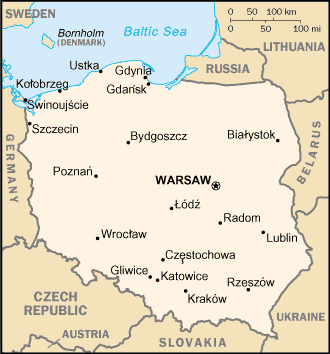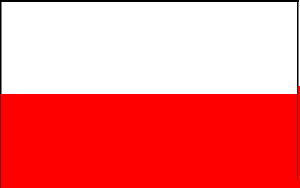
|
Poland
Background:
Poland is an ancient nation that was conceived around the middle of the 10th
century. Its golden age occurred in the 16th century. During the following
century, the strengthening of the gentry and internal disorders weakened the
nation, until an agreement in 1772 between Russia, Prussia, and Austria
partitioned Poland. Poland regained its independence in 1918 only to be overrun
by Germany and the Soviet Union in World War II. It became a Soviet satellite
country following the war, but one that was comparatively tolerant and
progressive. Labor turmoil in 1980 led to the formation of the independent
trade union "Solidarity" that over time became a political force and by 1990
had swept parliamentary elections and the presidency.
Location:
Central Europe, east of Germany.
Area: Total: 312,685 sq km, water: 8,220 sq km, land: 304,465 sq km.
Area - comparative: Slightly smaller than New Mexico.
Land boundaries: Total: 2,788 km, border countries: Belarus 407 km, Czech
Republic 658 km, Germany 456 km, Lithuania 91 km, Russia (Kaliningrad Oblast)
206 km, Slovakia 444 km, Ukraine 526 km.
Coastline: 491 km.
Climate and Terrain:
Climate: Temperate with cold, cloudy, moderately severe winters with frequent
precipitation; mild summers with frequent showers and thundershowers.
Terrain: Mostly flat plain; mountains along southern border.
Natural resources: Coal, sulfur, copper, natural gas, silver, lead, salt,
arable land.
People:
Population: 38,625,478.
Ethnic groups: Polish 97.6%, German 1.3%, Ukrainian 0.6%, Belarusian 0.5%.
Religions: Roman Catholic 95% (about 75% practicing), Eastern Orthodox,
Protestant, and other 5%.
Languages: Polish.
Government:
Government type: Republic.
Capital: Warsaw.
Independence: 11 November 1918 (independent republic proclaimed).
Economy overview:
Poland has steadfastly pursued a policy of liberalizing the economy and today
stands out as one of the most successful and open transition economies. The
privatization of small and medium state-owned companies and
a liberal law on establishing new firms have allowed for the rapid development
of a vibrant private sector. In contrast, Poland's large agricultural sector
remains handicapped by structural problems, surplus labor, inefficient small
farms, and lack of investment. Further progress in
public finance depends mainly on privatization of Poland's remaining state
sector. s
Statistics:
Telephones - main lines in use: 8.07 million.
Telephones - mobile cellular: 1.78 million.
Radio broadcast stations: AM 14, FM 777, shortwave 1.
Radios: 20.2 million.
Television broadcast stations: 179 (plus 256 repeaters).
Televisions: 13.05 million.
Internet users: 3.5 million.
Railways: Total: 23,420 km.
Highways: Total: 381,046 km, paved: 249,966 km, unpaved: 131,080 km.
Airports: 122, with paved runways: 83, with unpaved runways: 39.
Heliports: 3.
Return to Visiting Locations
|

